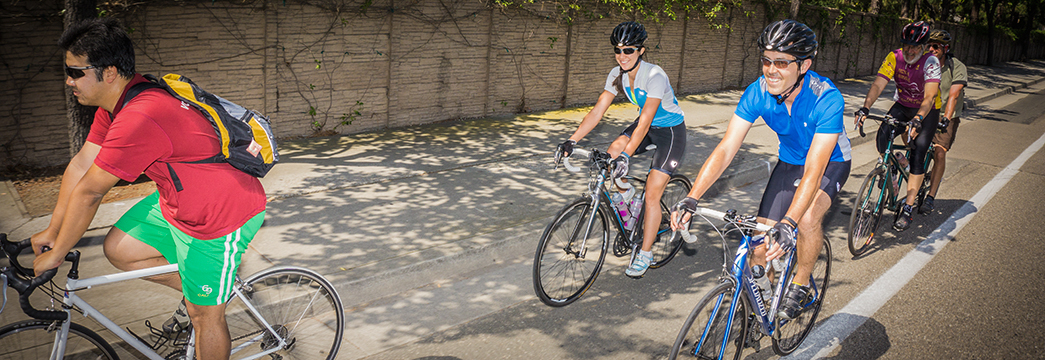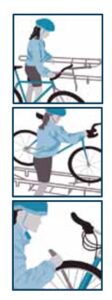Bike Santa Barbara County
Biking in Santa Barbara County
Bike Map
Santa Barbara County Bike Map
The Santa Barbara County Bike Map is one of the most popular items produced by Traffic Solutions. We last updated our print map in 2013. The print map features useful riding tips, rules of the road, and contact information to report hazards. You can download the print for both North Santa Barbara County and South Santa Barbara County.
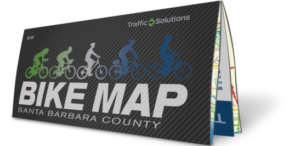
We took a ‘detour’ with our bike map update. We compiled updated, designated bike routes in the map below. We recommend using this map to compliment trip planning in Google Maps. For those unfamiliar with Google Maps, here are some tips:
- Search for directions like normal.
- Select the cycling icon above the search bar.
- Select a recommended route.
- Use the map below to consider parallel bike infrastructure.
- Return to Google maps and drag the route lines on the map to create a custom route.
- Use the ‘person icon’ at the bottom-right of the screen to Street View the route and manage your expectations.
If you click lines on the map below, you may see a rating system of Easy, Medium, and Challenging (almost completely related to Class I, II, and III infrastructure). Please use this map as a reference and understand that it is clunky and contains duplicate lines. We hope to deliver a bike map unlike anything you have ever seen by 2026 (more details below map).
Apps: Route Finding and Tracking
With the advent of mobile technology and GPS – it’s easier than ever to plan a bike trip and find your way en route.
Check out the apps listed below as tools to help you navigate, log your miles traveled, monitor vehicle miles saved, see your carbon offset and check fitness stats.
 Strava – Track your runs and rides with GPS, join Challenges and see how your running and riding compares with friends. Follow routes you’ve created or found and view your activity map as you record. Get key stats like distance, pace, speed, elevation gained and calories burned. This app can be linked with the Commute Tracker app below. Available for iPhone and Android
Strava – Track your runs and rides with GPS, join Challenges and see how your running and riding compares with friends. Follow routes you’ve created or found and view your activity map as you record. Get key stats like distance, pace, speed, elevation gained and calories burned. This app can be linked with the Commute Tracker app below. Available for iPhone and Android
 Map My Ride – Track and map every ride with MapMyRide. For every mile you go, you’ll get feedback and stats to help you improve your performance. Discover new workout routes and save or share your favorites, and get inspired to reach new cycling goals with a 40 million member strong community of athletes. Whether you’re a beginner on your first climb. Available for iPhone and Android
Map My Ride – Track and map every ride with MapMyRide. For every mile you go, you’ll get feedback and stats to help you improve your performance. Discover new workout routes and save or share your favorites, and get inspired to reach new cycling goals with a 40 million member strong community of athletes. Whether you’re a beginner on your first climb. Available for iPhone and Android
 Google Maps – Google Maps makes navigating your world faster and easier. Find the best places in town and the information you need to get there. Available for iPhone and Android
Google Maps – Google Maps makes navigating your world faster and easier. Find the best places in town and the information you need to get there. Available for iPhone and Android
![]() Commute Tracker – Commuters in Santa Barbara County are invited to use the Commute Tracker app, to log bike trips, calculate commuter savings, and participate in their employer commuter programs. It syncs with your own SmartRide.org commuter account. Available for iPhone and Android
Commute Tracker – Commuters in Santa Barbara County are invited to use the Commute Tracker app, to log bike trips, calculate commuter savings, and participate in their employer commuter programs. It syncs with your own SmartRide.org commuter account. Available for iPhone and Android
E-Bike Safety Tips & Pledge
More and more community members are discovering the joys and positive impacts associated with electric bikes. The California Highway Patrol and People for Bikes have developed safety curriculum for a growing population of e-bike users. We recommend you rely on CHP and People for Bikes but have summarized our tips here to help you get started. Our E-Bike Safety Pledge encourages Santa Barbara’s County’s residents to treat all road users with patience and respect–let’s look out for each other! Watch a short safety video and complete the pledge to drive, bike, e-bike, and walk with others in mind. Read on for some safety and operational tips specific to e-bikes.
E-bike etiquette is becoming a hot topic! Many e-bike users have not sought or received the training they need to ride safely, legally, and cooperatively. Let’s celebrate the growing number of people biking and learn some important safety tips.
- TIP #1: ABC Quick Check (air, brakes, chain, crank)
- Fill to max PSI shown on your tire.
- Check that your quick release levers are closed.
- E-bike brakes wear out faster than regular bike brakes; adjust and replace regularly.
- Apply 70% front and 30% back when braking.
- Brake levers should stop short of handlebar when pulled.
- Lube chain if it looks dry.
- Check crank for rattling by moving a pedal back and forth.
- Tip #2: Farther by Bus/Rail
-
- Consider e-bike weight and tire size if purchasing an e-bike you plan to use on the bus or train.
- Learn how to use your bus’s bike rack.
- Make sure you are comfortable lifting your bike onto racks or into luggage bins (coach buses).
- Buy a folding e-bike if you know rack or luggage bin are in high demand on your route.
- Reserve your space on Amtrak to reserve one of eight (8) bike parking spaces.
- Tip #3: Ask an E-Bike Guru
- Learn about watts, volts, amp hours, and Newton meters of torque to make sure you buy an e-bike with enough power.
- If you are replacing your car, consider a mid-drive e-bike.
- Buying an e-bike with a hub motor will save money.
- There are more than 225 brands of e-bikes, including models that fold, are lightweight, carry cargo, or go faster.
- Tip #4: Know the Law
- E-bikes must be equipped with a brake capable of making a one-wheel skid on dry, level pavement.
- Your e-bike must have a red rear reflector visible from a distance of 500 feet.
- E-bikes traveling slower than the normal speed of traffic must ride as close to the right as practical, except when passing another bike or vehicle, when preparing for a left turn, or avoiding a road hazard.
- E-bikes cannot hitch rides on vehicles.
- E-bike must have a permanent seat.
- E-bike riders may ride on the shoulder of any roadway unless specifically prohibited.
- E-bike riders on the shoulder must ride on tin the same direction as traffic.
- E-bike riders cannot ride on a toll bridge unless permitted by signs.
- Tip #5: Crash Considerations
- Take care of injuries.
- Take a photo or note details (vehicle color, make model, driver description, damage).
- Do not negotiate with the driver.
- Document contact and insurance information while waiting for the police.
- File a police report.
- Save receipts for all medical and repairs.
- Tip #6: Select Your Class
- Class 1 e-bikes are pedal-assist up to 20mph.
- Class 2 e-bikes have a throttle assist up to 20mph.
- Class 3 e-bikes are pedal assist up to 28mph. A helmet is required. Class 3 e-bikes are typically not allowed on paths or in bike lanes.
- Tip #7: Time Your Pass
- Look for cars when passing another bicyclist.
- Take the lane when passing a right-turning vehicle. Drivers will not expect your e-bike’s speed.
- Do not pass in an intersection.
- Tip #8: Carry Passengers Safely
- Passengers under 18 must wear a helmet.
- Do not carry passengers on a class 3 e-bike.
- Do not exceed your e-bike’s weight limit with passengers.
- Do not try to carry passengers without a passenger seat.
- Tip #9: Balance your Load
- Carrying something with your hands is awkward. You must have one hand on the handlebar.
- Look up the weight limit for your bike rack and do not exceed it.
- Buy two panniers if you regularly carry gear or groceries.
- A class 2 e-bike (with throttle) can make it easier to carry heavy loads.
- Tip #10: Charge It Up
- It takes between 2 and 7 hours to charge most e-bikes.
- Charge your e-bike to roughly 60% for long-term storage.
- Use the charger that came with your e-bike to prevent a battery fire. If you want to go beyond typical safety, buy a fire extinguisher rated for lithium.
- One red flag to keep in mind when shopping for e-bikes is their online price, especially if they skirt just under $800. This is because the largest issue around bad actor batteries stems from the US de minimis import clause, which allows any imported products priced under 5/7 $800 entry into the country without requiring any taxation or inspection. So, if a bike is priced at $799.99, be aware!
Riding Tips
When you are bicycling, always ride predictably and defensively, be visible, use hand signals and obey the rules of the road. The bicycle is a legitimate form of transportation, consider yourself to be a driver of a vehicle when you are cycling. For additional riding tips, visit www.bikeleague.org.
Map Your Route
Plan your trip using the bike map resource on this page. Plan a route within your equipment or personal abilities (5 miles on an acoustic bike or up to 90 miles on certain e-bikes). Pedal more and throttle less to increase your range on an e-bike.
Dress the Part
Avoid dangling items, like hoodie ties. Wear flat-heel shoes, reflective items, and bright/comfortable clothes.
Finger Helmet Rule
Use two parallel fingers to space the top of your brown to the bottom of your helmet. Make those fingers into a “V” shape at the base of your ear and adjust straps to match. Use one finger to space the helmet strap and your chin.
Street Skills 101
Practice quick turns, avoiding obstacles, and different positions on your bike.
Ride with Traffic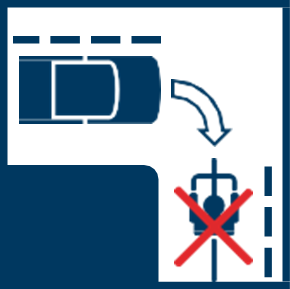
Always ride in the same direction as traffic. Motorists and other road users are not looking for bicyclists riding on the wrong side of the road. Cyclists have the same privileges and responsibilities as drivers of motor vehicles.
Use Hand Signals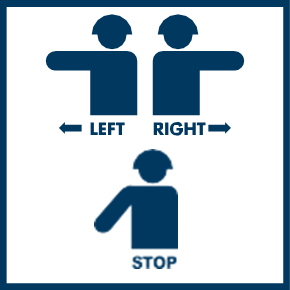
Signal to other drivers. Hand signals tell everyone what you intend to do: turn left, turn right or stop. Signal as a matter of law, courtesy and self-protection.
Be Predictable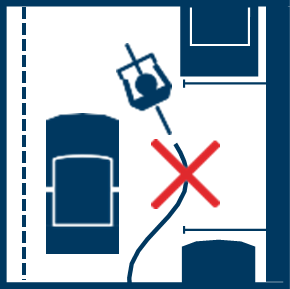
Obey traffic signs and signals. Stay on a steady, predictable course as if driving a car. Don’t weave in and out of parked cars
because motorists may not see you when you move back into traffic. Scan behind you and signal well in advance if you intend to turn or merge into another lane.
Intersections and Lane Positioning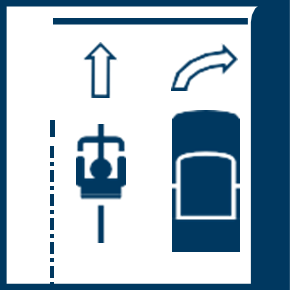
If you are turning, watch for cars, signal and merge carefully to the center of the turn lane. Make your turn occupying the same space an automobile would. If you are going straight, stay in the rightmost through lane. When in doubt at a busy intersection, pull over and become a pedestrian so you can use the sidewalks and crosswalks.
Ride a Well-Equipped Bike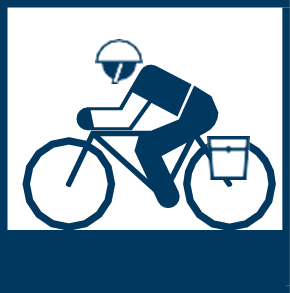
Be sure your bike is adjusted to fit you properly and is in good working condition. Important gear includes a helmet, bike lights, reflectors, patch kit and air pump. A basket or pannier can help you carry items – let the bike carry things for you.
Night Riding – Use a Light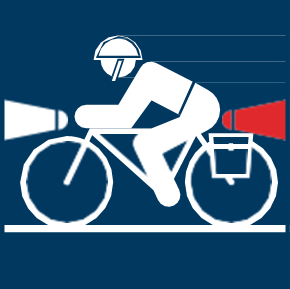
State Law requires bikes to have a front light visible from 300 ft., a back reflector visible from 500 ft. and pedal and side reflectors. A red flashing rear light and wearing light colored or reflective clothing further increasing visibility.
Watch for Car Doors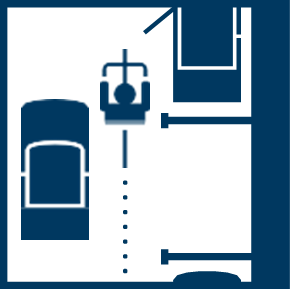
Stay out of the door zone. When riding along a street with parked cars, leave approximately 3-4 feet between you and the parked cars. The law does not require you to stay to the right or to ride in a bike lane if it is hazardous to do so.
Avoid Road Hazards
Look farther down the street to anticipate changes in the road; try to avoid potholes, drain grates and other hazards. Cross railroad tracks at a right angle.
Stay off Sidewalks Yield to Pedestrians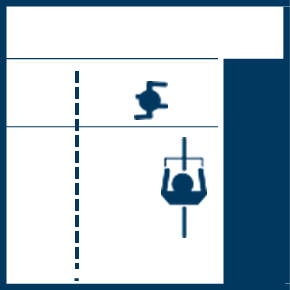
Sidewalks are designed for pedestrians. Sidewalk riding is a leading cause of bike crashes and makes you less visible to motorists. Yield to pedestrians at crosswalks and intersections; they legally have the right of way.
Don’t Pass on the Right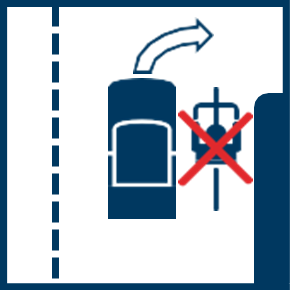
Many crashes occur when cars turn right into the path of a bicyclist. This can be avoided by moving out of the right hand turn lane when you are proceeding straight.
Use a Lock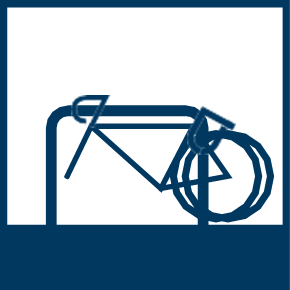
Never leave an unlocked bike unattended – keep it locked to a bike rack or in a bike locker. Use a U-lock or heavy cable and make sure to lock your wheels as well as your frame.
Share the Trail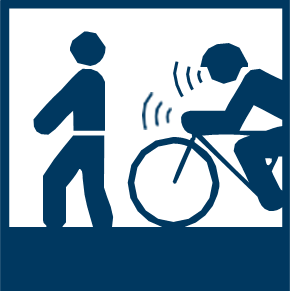
Alert others when passing, by using your voice (“on your left”) or a bell. Watch your speed when sharing the path – dogs and children are unpredictable. Slow down and look both ways when the trail crosses roads or driveways.
Roundabouts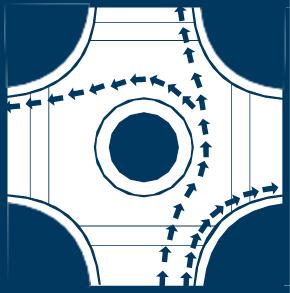
Take the lane and ride with traffic. While roundabouts don’t have striped bike lanes, traffic moves slowly, allowing bicyclists and motorists to share space. Bicyclists have the same rights and responsibilities as motorists while in the roundabout. Choose the proper lane position for your direction, just like a car. You can also dismount and walk your bike on the sidewalk.
Register Your Bike
Prevent bike theft!
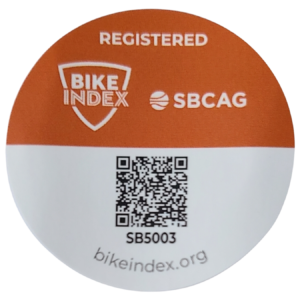
Lock It Up
-
- Consider high-security brands like ABUS, Otto, or Kryptonite New York. Expect to spend more than $150.
- Use multiple locks to discourage thieves.
- Use a cable to lock in your wheels with your primary e-bike lock.
- You can buy lockable skewers and seat posts to prevent tire and seat theft.
- Park in a highly visible area.
- Always lock your bike, even when parking inside (garage, home, balcony, etc.).
We recognize having your bike stolen will reduce how many bike trips you make. If you love your ride, visit our Bike Index registration page to submit your email, serial number, and a photo of your bike. Whether it gets found in Santa Maria or New York, law enforcement will know how to find you should your bike get stolen. Let’s hope it doesn’t happen, but if it does, you’ll be glad you did. Adding a QR sticker can increase visibility for would-be-thieves and law enforcement. The stickers are hard to remove, and a thief may opt for a softer target. See the “Community Partners” section below to find a participating bike shop near you.
Shops
No matter the type of rider, Santa Barbara County has a shop to support every need. We encourage buying your next ride local. You will benefit from local knowledge, warranties, and repairs.
Santa Barbara County Bike Shops
Bici Centro Santa Barbara – 434 Olive St., Santa Barbara, CA 93103. Phone (805) 617-3255.
Bici Centro City College – Santa Barbara City College east campus.
Bici Centro Santa Maria – 310 E. Oak St,. Santa Maria, CA 93454. Phone (805) 697-1297.
Bikesmiths – 5441 Carpinteria Ave., Carpinteria, CA 93013. Phone (805) 684-3150.
Cycle Star – 560 E. Betteravia, Suite G, Santa Maria, CA 93454. Phone (805) 347-1950.
Dr. J’s Bike Shop – 1693 Mission Dr., Solvang, CA 93463. Phone (805) 688-6263.
e-Bikery – 590 E. Gutierrez Street, Santa Barbara, CA 93103. Phone (805) 869-2574.
Electric Bikes of Santa Barbara – 1345 State St., Santa Barbara, CA 93101. Phone (805) 963-8885
Electric Star Power Bicycles – by appointment-only in Santa Barbara. Phone (805) 637-3117.
Fastrack – 118 W. Canon Perdido St., Santa Barbara, CA 93101. Phone (805) 884-0210.
Gonzo Cycles – 4859 Carpinteria Ave., Carpinteria, CA 93013. Phone (805) 242-2554.
Hazard’s Cyclesport – 110 Anacapa Street, Santa Barbara, CA 93101. Phone (805) 966-3787.
Isla Vista Bicycle Boutique – 880 Embarcadero del Mar, Isla Vista, CA 93117. Phone (805) 968-3338.
Mad Dogs & Englishmen Bike Shop, Montecito – 1080 Coast Village Rd., Santa Barbara, CA 93108. Phone (805) 837-0033.
MainStreet Cycles – 311 E. Main, Santa Maria, CA 93454. Phone (805) 922-5577.
Open Air Bicycles – 135 East Carrillo St., Santa Barbara, CA 93101. Phone (805) 962-7000.
Pedego Los Olivos – 2948 San Marcos Ave. Suite E., Los Olivos, CA 93441. (805) 691-3045
Play It Again Sports – 4850B Hollister Avenue (@Turnpike), Santa Barbara, CA 93111. Phone (805) 967-9889.
Stape Cycles – 224 Anacapa St., 1A, Santa Barbara, CA 93101. Phone (203) 451-8023.
REI – 321 Anacapa St., Santa Barbara, CA 93101. Phone (805) 403-9521.
TREK – 320 S. Kellog Ave., Goleta, CA 93117. Phone (805) 682-4699
Varsity Bike Shop – 6549 Pardall Rd, Isla Vista, CA 93117. Phone (805) 968-4914.
Velo Pro – 5887 Hollister Avenue, Goleta, CA 93117. Phone (805) 964-8355.
Velo Pro – 15 Hitchcock Way, Santa Barbara, CA 93105 (805) 963-7775.
Organizations & Clubs
MOVE Santa Barbara County and other organizations play an important role in advocating for and promoting bicycling as accessible, healthy, and practical for everyday transportation.
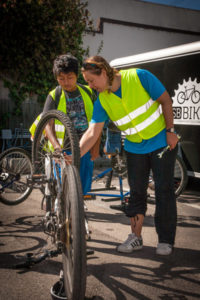 MOVE Santa Barbara County (MOVE)
MOVE Santa Barbara County (MOVE)
Our close collaborators at MOVE have been working to make Santa Barbara a great place to ride a bike for over 30 years. By working with city administrators, educators, and planners, they’re committed to making biking safe, accessible, and enjoyable for everyone.
The organization is also home to three Bici Centros, which are community bicycle workshops and bike thrift stores! Santa Barbara Bici Centro, Santa Maria Bici Centro, and SBCC’s Bici Centro City College. For repairs, it’s a DIY (do-it-yourself) deal–you fix it, and you learn it with help from staff. The fee of $5 per hour includes use of tools, materials, space, and expertise. Knowledgeable, bilingual staff and volunteers are always around to guide you through repairs. Their shop also sells inexpensive refurbished bikes, used parts, and accessories.
MOVE also provides advocacy, education, and outreach to improve transportation options in the Santa Barbara and Ventura Regions, promoting rail, bus, bike and pedestrian access. They promote convenient transportation alternatives for everyone including the one-third of the population who, by choice or necessity, does not drive.
Regional Bike Clubs & Organizations
B4T9 Women’s Cycling Team
Echelon Santa Barbara
Tailwinds Bicycle Club
UCSB Cycling
Commuting
Biking to work fights pollution, keeps you fit, avoids traffic delays, saves money, and above all, makes your commute enjoyable!
Tips to Get Started
- Move your bike from the back of the garage to the front of the garage (remove tiny barriers that keep you from biking to work)!
- Determine the best route and do a “trial run” to familiarize yourself with the route, as well as check timing issues.
Contact us for route planning assistance and check out our Santa Barbara County Bike Map on this page. - Make sure you have a helmet, bike lock, reflectors, bike lights, and a basket or pannier. Your bike doesn’t have to be “top of the line” but it should be tuned up and in good working order.
Low cost bike helmets ($9) are available through the Santa Barbara County Public Health Department. Call (805) 681-5432 for more information. Low cost helmets are also available at some elementary and junior high schools and distribution events, hosted by MOVE Santa Barbara County. - Learn more from The League of American Bicyclists.
How to Load on Public Transit
Use this guide to prepare for taking your bike on the bus or train.
Bus – Load/Unload
- Load from curb side of bus – do not step into traffic.
- Squeeze the handle to release the folded rack.
- If there is no other bike in rack, use inside slot.
- Load bike with front wheel on side labeled “front” and pull and raise the support arm over the front tire.
- Alert the driver and exit through the front door. Raise and drop the support arm to remove the bike.
- Fold up rack if no other bike is in rack.
Train
- Most Amtrak® Pacific Surfliner® trains are equipped with racks for six bicycles located in the “cab car,” available by reservation only. Reservations are not available on some trips or on connecting thruway buses.
- Boxed bikes are allowed on long-distance Reservations are required on the Pacific Surfliner.
- Folding bicycles (34” X 15” X 48” or smaller) are allowed onboard all trains as carry-on baggage.
- Passengers traveling on Amtrak Coast Starlight® trains 11 and 14 or connecting to the Southwest Chief® or Sunset Limited® in Los Angeles will be required to check the bike in a bicycle box, available for purchase for $10.00.
For assistance call: 1-800-USA-RAIL (1-800-872-7245) or visit Amtrak.com/baggage-policy.
Bike Lockers to Keep Your Bike Secure While Working
- City of Lompoc – Phone (805) 875-8266
- City of Santa Barbara – Phone (805) 564-5656
- Orcutt 135/Clark (west) Park & Ride – Phone (805) 963-SAVE
CycleMAYnia is Bike Month
Something for everyone…
The month of May is CycleMAYnia on Santa Barbara’s South Coast. Traffic Solutions and other community organizations coordinate rides, classes and clinics, social gatherings, family outings, workplace competitions, and more.
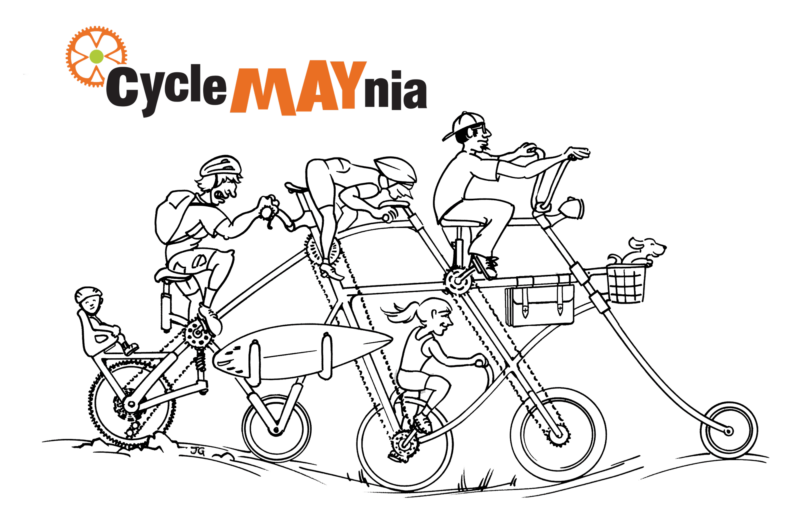
In 1994 we launched ‘Bike to Work Day’ in the cities of Santa Barbara and Goleta. It then became a week, and now it’s a month, reaching thousands of cyclists and community members. Led by Traffic Solutions, CycleMAYnia is a collaboration of organizations, agencies, businesses and community volunteers, working together to host a broad month of activities. This model enables us to host select anchor events with core staff and experienced volunteers, which are then complemented by dozens of smaller profile events. With the excitement generated by this month of great bicycle-centric events, we aim to reach not only those commuters and recreational riders, but beyond – to the community at large curious about this two-wheeled renaissance. Learn more at CycleMAYnia.org.
Recreational Cycling
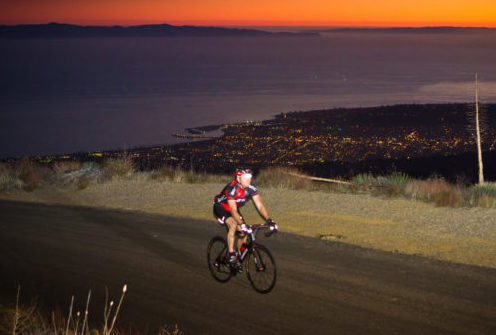 Santa Barbara County is home to some of the most desirable and diverse cycling destinations in the world.
Santa Barbara County is home to some of the most desirable and diverse cycling destinations in the world.
From the beachside paths and historically rich bike routes of Santa Barbara proper (often referred to as the American Riviera), to the world class road climbs and rugged trails in the Los Padres mountains – beyond into the rolling hills of our famous wine country and on to the scenic backroads of the Santa Ynez Valley, Santa Maria and coastal North County – there’s no shortage of places to ride and plenty of resources to connect you to the best option for your cycling desires.
Resources
- For a comprehensive guide to all kinds of great cycling opportunities, visit: Cycle Cal Coast.
- Wheel Fun Bike Rentals offers a large selection of surreys, specialty cycles, bicycles, Taga Bikes, and more – fun for the whole family! You can ride along the coastline path, explore the Santa Barbara harbor and explore this great city on wheels!
- Families will appreciate Neighborhood Routes available from the Walk & Roll program.
Report Hazards & Crashes
Contact the following offices to report specific hazards at locations. In case of emergencies, dial 9-1-1.
If you have a near-miss, fall, hazard, or theft to report to the cycling community, please visit: BikeMaps.org, a project of UC Santa Barbara.
City of Buellton – Phone (805) 688-5177
City of Carpinteria – Phone (805) 684-5405
City of Goleta – Phone (805) 961-7570
City of Lompoc – Phone (805) 875-8021
City of Santa Barbara – Streets Phone (805) 564-5385 | Pothole Hotline (805) 897-2630
City of Santa Maria – Phone (805) 925-0951
City of Solvang – Phone (805) 688-5575 ext 228
Santa Barbara County Roads – Glass, debris, foliage phone (805) 681-5678 | General bikeway suggestions (805) 568-3576
State Highway System (101, 246, 1, 154), Caltrans – Phone (805) 549-3318
UC Santa Barbara – Phone (805) 893-8300
Laws
This is a summary of the bicycle provisions of the California Vehicle Code. Readers should check the Vehicle Code for more detailed information at www.dmv.ca.gov or by calling 1-800-777-0133 or TTY 1-800-368-4327.
- § 21200. Bicycle riders have all the rights and responsibilities of vehicle drivers.
- § 21200.5. It is against the law to ride a bicycle while under the influence of alcohol or drugs.
- § 21201. Bicycles must be equipped with a brake capable of making a one-wheel skid on dry, level pavement. Handlebars must not be higher than the rider’s shoulders. The bicycle must be small enough for the rider to stop, support it with a foot on the ground, and restart safely. Every bicycle operated at night must have the following equipment:
- A white headlight, or a white light attached to the rider and visible from the front from a distance of 300 feet.
- A red rear reflector visible from a distance of 500 feet
- White or yellow reflectors on each pedal, shoe or ankle
- A white or yellow side reflector on the front portion of the bicycle and a white or red reflector on the rear portion of the bicycle, or reflectorized tires
- § 21202. Bicyclists traveling slower than the normal speed of traffic must ride as close to the right as practicable, except in the following situations:
- When passing another bicycle or vehicle
- When preparing for a left turn
- To avoid hazards that make it unsafe to stay far to the right (e.g. a parked car door opening or substandard width lanes)
- On one-way streets, bicyclists may ride as near the left as practicable.
- § 21203. Bicyclists may not hitch rides on vehicles.
- § 21204. Bicycles must have a permanent and regular seat unless designed by the manufacturer to be ridden without one. Passengers must have a separate seat, and passengers 4 years old or younger, or weighing 40 pounds or less, must have protection from moving parts and wear a helmet meeting Snell or ANSI standards.
- § 21205. Bicyclists may not carry any package or article that prevents them from keeping at least one hand on the handlebars.
- § 21210. It is illegal to leave a bicycle on its side on a sidewalk, or park it in any way that blocks pedestrians.
- § 21212. All bicyclists younger than 18 years old must wear a properly fitted and fastened bicycle helmet that meets Snell or ANSI standards when operating a bicycle.
- § 21650. Bicyclists may ride on the shoulder of a roadway unless it is specifically prohibited.
- § 21650.1. Bicyclists on the shoulder must ride in the same direction as traffic on the roadway.
- § 21960. Bicyclists may not ride on freeways where signs prohibit it.
- § 23330. Bicyclists may not cross a toll bridge unless permitted by signs.
- § 27400. Bicyclists may not wear earplugs in both ears or a headset covering both ears. This section does not apply to hearing aids.

